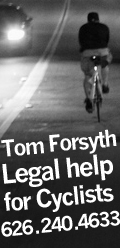DIY Police Education Poster

Thread started by
tortuga_veloce at 06.12.09 - 1:43 pm
I'm putting together a poster to help police understand bicycle law and identify dangerous drivers. Police officers take cues from their own experience driving in LA. Because most police officers can't relate to the threats experienced by cyclists, they often go unnoticed.
Think about it: have you ever been cut off in front of a cop and nothing happens? This was explained to me by a sympathetic officer: police watching for unsafe passes will look to see if a car hits its brake lights. Since bikes don't have brake lights, they don't pay attention.
I'm trying to identify ways to explain bicycle law to police officers and I need your help. This is what I have so far. Please contribute your thoughts and experiences. I need your help! Let's teach the teachers!
(This will likely include the LADOT bicycle law summaries and the bicycle safety page from DMV.ca.gov)
---
âCHEATER BOOK:â
The LAPD's "Cheater Book" is a valuable tool for every law enforcement officer
21202 BIKE-SLOW MOVING Ride as near the right hand curb or edge of the roadway as
practicable. EXCEPTIONS: May use left on one way street."
CVC 21202 (a3) actually gives cyclists the right to âtake the laneâ in many circumstances. Taking the lane allows cyclists to stay away from the deadly âdoor zoneâ and forces drivers to change lanes to pass, instead of trying to pass at an unsafe distance or running the cyclist into the curb.
Cyclists are allowed to take the full lane:
(1) When overtaking and passing
(2) When preparing for a left turn at an intersection or into a private road or driveway.
(3) When reasonably necessary to avoid conditionsâ¦including, but not limited to⦠surface
hazards, or substandard width lanes ( a lane that is too narrow for a bicycle and a vehicle to travel safely side by side within the lane. )
(4) When approaching a place where a right turn is authorized.
The San Francisco Police Department recommends riding at least three (3) feet from the âdoor zoneâ of cars parked on the right side of the road. Using this rule of thumb, if you are riding three feet away from cars on the right, and if a car cannot safely pass you in the lane, you should ride in the center of the lane to prevent cars from trying to squeeze next to you.
GETTING CUT OFF
21750. The driver of a vehicle overtaking another vehicle or a bicycle proceeding in the same
direction shall pass to the left at a safe distance without interfering with the safe operation of the
overtaken vehicle or bicycle, subject to the limitations and exceptions hereinafter stated.
Amended Sec. 7, Ch. 674, Stats. 1996. Effective January 1, 1997.
How can you tell when a bike gets cut off?
Since bicycles donât have brake lights, itâs harder to tell when a cyclist is being cut off. You need a keen eye to spot drivers who threaten cyclists
⢠If you see a car passing a cyclist only to brake directly in front of them
⢠If the cyclist has to change lanes to pass immediately afterwards
CAN BIKES RIDE ON THE SIDEWALK?
Sidewalk Riding (LAMC 56.15) Prohibits the riding of bicycles (or other human power devices) on sidewalks (bikeways or boardwalks) with a willful or wanton disregard for the safety of persons or property. Disallows the riding of bicycles on Ocean Front Walk in Venice. (summary by LADOT)
LAMC SEC. 56.15 BICYCLE RIDING â SIDEWALKS
1. No person shall ride, operate or use a bicycle, unicycle, skateboard, cart,
wagon, wheelchair, rollerskates, or any other device moved exclusively by human
power, on a sidewalk, bikeway or boardwalk in a willful or wanton disregard
for the safety of persons or property. (Amended by Ord. No. 166,189, Eff. 10/7/90.)
DISCLAIMER â RIDING ON THE SIDEWALK IS MORE DANGEROUS THAN THE STREET
âThe average cyclist in this study incurs a risk on the sidewalk 1.8 times as great as on the
roadway, and the result is statistically significant (p<0.01).â
Wachtel and Lewiston, âRisk Factors for Bicycle-Motor Vehicle Collisions at Intersections,â ITE J.,
Sept. 1994, [http://www.bicyclinglife.com/Library/Accident-Study.pdf]
 -->
-->



